|
Whether it's moving to college, an apartment, a house or a condo, most of us change our place of residence at least a handful of times during our lives.
Moving can be exciting, stressful, fun, challenging, and
rewarding. It can also be expensive and time-consuming and can generate waste, pollution and greenhouse gasses.
Here are some ideas to help make your next move eco-friendly,
not eco-wasteful.
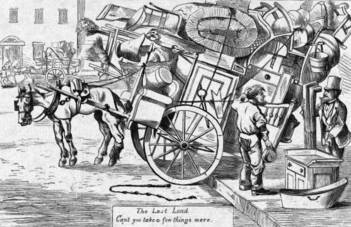
Lighten the load
Given the choice, most of us would prefer to move 15 boxes
verses 50+. Paring down possessions
before a move not only saves our backs and knees, it also has earth-friendly
benefits! Less stuff means:
-
Reduced need for packing materials (boxes, tape, newsprint,
packing peanuts).
- Fewer move-related trips, so less fuel and fewer vehicle emissions.
-
Less waste to dispose of at move’s end.
In the weeks and months leading up to your move, create and execute
a plan for reducing your belongings.
-
Organize
and declutter. There are a lot of online websites, lists, and books on
organizing and decluttering—some examples include lifehacker.org
and becomingminamalist.com.
Find and follow the approach that works best for you. Make sure to give
yourself adequate time for decluttering so you’re not feeling pressured to unnecessarily pack or
discard things at move time.
-
Use, donate
or sell. Use up food in your cupboards, fridge or freezer, or donate to a local food bank. Use email,
Facebook or sharing sites like NextDoor.com
to let friends and neighbors know of things you’re trying to sell or
give-away, and/or hold a moving sale. Twin Cities Free Market, Freecycle, and Craigslist are also worthwhile places to list things.
-
Properly
dispose of household hazardous wastes. Check with your county or city or
use the MPCA’s online
search tool for information on where to safely dispose of paints, lawn care
products, pesticides, and similar items.
Don’t flush expired or leftover medications
down the drain or toilet. They can end up in lakes, streams and other water
bodies, where they pose a hazard to fish and other wildlife, or even in your
drinking water. Refer to the MPCA’s Managing unwanted medications webpage for information on how to dispose of them safely.
Hennepin County just released a
cool new resource. The Donation
Opportunities brochure (PDF) provides information on organizations that
accept donations for a wide variety of items. Also check out the county’s
factsheet—Reducing
waste and recycling during your move—for some excellent suggestions and
guidance.
More resources:
ReThink Recycling
Infographic:
Reuse, Reduce & Relocate
|
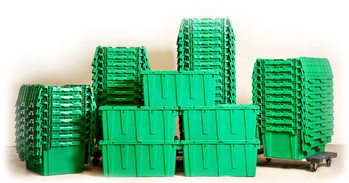
Packing/unpacking
Boxes and packing materials are necessities before
and during a move, but can be a challenge to deal with once they’ve served
their purpose. Fortunately, low- or no-waste packing options are more common
than they once were, giving consumers some greener choices.
-
Reusable moving
crates & containers. Several
companies now offer heavy-duty plastic crates for rent that take the place of
cardboard boxes. Others offer strong, reusable (and returnable) cardboard
boxes. In most cases, businesses deliver the crates or boxes directly to consumers
and pick them up at move’s end. To find a list of businesses
offering this service, search online for “reusable moving boxes MN,” or ask
your moving company if they provide them.
-
Creatively
use what you have. Ditch the bubble wrap and packing peanuts! In their
place, try packing with blankets, sheets, towels, clothing, and similar items
that you already possess.
-
Use
eco-friendly packing materials. Biodegradable
packing materials, such as those made from cornstarch, are purported to be less
toxic to the environment. Possible retail sources: office supply stores, moving truck rental
companies, home organization stores, and online retailers.
-
Request cast-offs. Ask friends and
family members to pass along their moving supplies once they’re done with them.
Other potential sources for materials: Craigslist (look under free category), Freecycle,
U-Haul Box
exchange, Twin Cities Free Market.
|
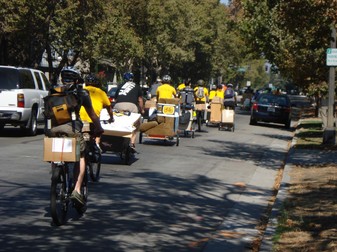 During the move
My nephew, Zac, is a devoted bicycling enthusiast and
environmentalist. When the time came to move from his former home to a new one several
miles away, he lined up a contingent of cycling buddies to help him move
belongings—couch and all—using bicycles
and trailers. Zac’s zero-carbon, human-powered move was an accomplishment
that I still marvel at years later.
Even if bike moving isn’t your thing, there are still plenty
of ways to reduce your carbon impacts.
-
Plan a
direct route. Reduce energy use and vehicle emissions by plotting as direct
a route as possible to your moving destination.
-
Plan
fewer trips. Efficiently loading the moving van or truck will help you to
reduce the number of trips that have to be made. See Expert Tips for some suggestions.
-
Renting a
truck or van? Right-size your vehicle. Choosing a vehicle that is too
small can mean excess trips. Choosing one that is too large can result in unnecessary
fuel consumption. Both can be bad for air quality and the environment.
-
Don’t
idle. Turn off your vehicle’s engine when it’s not moving. Idling wastes
fuel, emits toxic air pollutants, and contributes to global warming.
-
Inquire about
hybrid or biodiesel-fueled trucks. Some professional movers are now
including hybrid (diesel-electric) and/or biodiesel-fueled vehicles in their
fleets. These vehicles can get substantially better fuel economy, and emit fewer toxic emissions, than
conventional diesel-powered trucks.
Consider using sustainability as a criterion
for selecting a mover. Ask businesses what green practices and policies
they have in place (e.g., availability of reusable crates and biodegradable or recyclable packing materials). For examples of what some moving companies
elsewhere in the U.S. are doing to green their operations, see mymove.com.
|
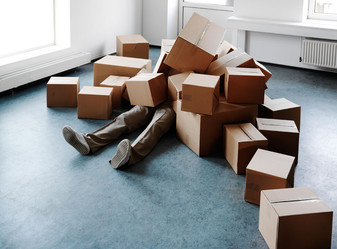 After the move
You may be tempted to chuck boxes and packing materials in the trash or recycling bin asap after moving. Instead, try finding new homes or uses for them.
Let friends and others know that you have
boxes available or advertise them on Craigslist or similar websites (refer to "Use, Donate or Sell" above). You can also try donating materials to shipping stores.
Depending
on the quality of your boxes, you may be able to sell them on one of the online
box broker sites. For more information, see 7 Ways to Get Rid of Moving Boxes After You Move.
|
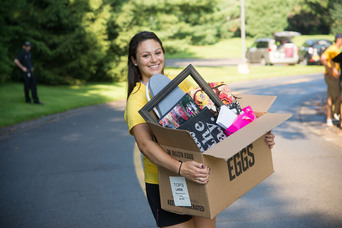
To & from college
Colleges are making it easier for students to practice the 3Rs (reduce, reuse, recycle)
during dorm or housing move-in and move-out. Examples include:
-
Special collections of cast-off furniture,
household goods and clothing for donation to charities.
-
Convenient placement and availability of recycling and reuse
containers throughout dorms and other campus buildings.
-
Bike and car sharing programs.
-
Other campus sharing resources,
like Concordia College’s Free
Store.
Students can also make a
difference by following some principals like the ones below.
Move-In
-
Leave
your car at home. Take advantage of campus bike-share and car-share programs,
or bring your bike with you.
-
Skip the
individual mini-fridge or microwave, which can use a lot of energy. If available, use
your dorm’s shared kitchen facilities, or consider sharing an
energy-efficient unit with dorm friends..
-
Pack
belongings in reusable crates that can be stored in your dorm room or
building.
-
Minimize
stuff. Too often, stuff that
seems cool and necessary at the beginning of the school year becomes waste by
year’s end. Only bring what you really need and will use. To avoid duplicate purchases, coordinate in advance with roommates on who's bringing what .
Check with your college to see what they provide--some colleges, for instance, rent common items like TVs. For the rest, shop
locally for durable, recycled, recyclable, second-hand, and/or reusable items.
Move-out
Waste tends to be at its highest
levels on college campuses during the months of May and June, when student
move-out is at a peak.
- Avoid the last minute rush to purge, pack and vacate by allocating time in the weeks prior to year's end to sort through your stuff. Sell, give away, or recycle what you no longer want.
- A lot of colleges now offer special programs designed to recover materials for recycling and reuse during move-out periods. Check with your college's sustainability office to see what's offered.
For more ideas, see Campus Initiatives.
|
Eco Experience at the Minnesota State Fair. August 25-September 5, 9 a.m. to 9 p.m. daily. The Eco Experience is a huge exhibit at the Minnesota State Fair, filled
with hands-on activities, demonstrations and resources. New exhibits this year include the “World’s Biggest Bike”, the Paul Bunyan Eco Zone, a living (green) wall, and much more!
Want to earn a ticket to the fair? Volunteer as a playworker at the Eco Experience nature play area! Volunteers are needed for 3-4 hour shifts to engage with families and ensure safety. For more information, see Playworker Eco Experience.
Thank you for reading Living
Green 365. This newsletter is a publication of the Minnesota Pollution Control
Agency. Please send questions or comments about living green to the address
below.
Sincerely,
Erin Barnes-Driscoll and the Living Green Team
livinggreen365.pca@state.mn.us
|